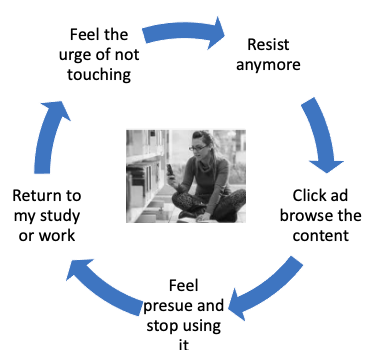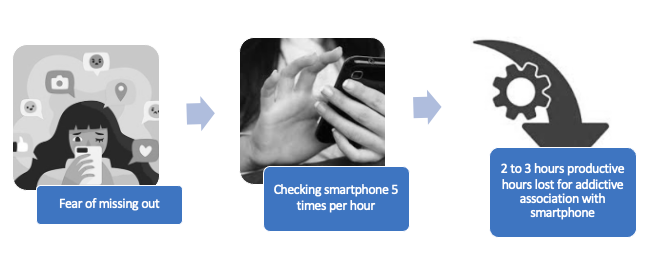Smartphone addiction refers to a lack of control over the temptation of frequently touching smartphones, despite the urge of not to do so due to knowing negative effects like social isolation, lack of attention span, and loss of productive time. A survey finds that as high as 22% of smartphone-using respondents admitted to checking their device every few minutes. Lack of control over using smartphones has been a concern. Notably, students are worse sufferers as it causes frequent interruptions and a lack of attention to study. In many situations, the temptation of frequent usage of smartphones has reached an addiction level. Smartphone addiction is a new social, productivity, and creativity-hurting problem.
The high penetration of the Internet and the availability of devices like smartphones have accelerated the growth of online education. Particularly pandemic has forced schools and universities to take refuge in online learning. Market research data indicate that the online education market will likely hit $350 Billion by 2025.
The smartphone appears to be preferable among access devices, particularly in developing countries. Some models cost less than computers. Moreover, they can run batteries for hours, which addresses the power intermittency issue. A recent survey in India has found the low penetration of smartphones as a barrier to the expansion of online education. To make smartphones a preferred delivery platform, there is competition in developing apps for assessment, authoring, distance tutoring, test preparation, collaboration, simulation, and many more. Despite promising possibilities, we run the risk that smartphone addiction undermines eLearning advantages.
Smartphone addiction

In fact, a smartphone is hugely a productive tool. Teledensity, smartphone penetration, or personal computer density are often used to measure development status. Increasing the supply of productivity tools and integrating smartphones with essential service and work processes makes the smartphone a key means of modern society. In addition to it, smartphone-based apps monitor our health and offer us news updates in real-time. There appear to be limitless possibilities. Among them, online learning or education over smartphones has been rapidly unfolding. Nevertheless, compulsive use of these devices can interfere with work, school, and relationships. The habit of spending time on social media or playing games, repeatedly checking texts, emails, or apps often leads to negative consequences in our life.
For many people, it has reached an alarming level. In fact, they have been suffering from a variety of impulse-control problems due to the overuse of smartphones. By the way, it is not the device itself. Instead, the games, apps, and online worlds that connect us create the compulsion problem. Smartphone app designers deliberately add such addictive features, as increased screen time leads to proportionate revenue from advertisements. Hence, it’s worth looking into whether smartphone addiction undermines eLearning advantages.
Students are addicted to smartphone
Among the students, having a fear of missing out if you don’t check your phone regularly is a common symptom. Moreover, they often feel the necessity of compulsively checking social media. Many of them are anxious that others have a better time or lead a more exciting life. Sometimes, get up at night to check the phone. A study of Indian students reveals that Indian college students check their phones about 150 times a day. Let’s estimate that they spend 9 hours sleeping and performing essential tasks like taking a shower, leaving 15 hours. Consequentially, it turns out that they check smartphones 10 times per hour, or once every 6 minutes. An estimate indicates that they spend 4-7 hours on their smartphones every day on average. A study reveals that 60% of U.S. college students consider themselves to have a smartphone addiction.
On top of it, smartphone penetration among college students is very high across the world. For example, as high as 87 percent of students of public universities in Bangladesh have a smartphone.

Addictive smartphone users are increasingly unable to think for themselves
In online education, contact between students and teachers is far less. To overcome this limitation, students need to have a greater thinking capability for following lectures delivered over the Internet. Unfortunately, the temptation to have frequent contact with smartphones reduces the thinking concentration of students. Even in their subconscious minds, students get captivated and hooked to a tantalizing and ever-increasing variety of functions. The temptation of always remaining informed and responding to friends’ posts first leads to pervasive and obsessive use of smartphones. Subsequently, despite offering a convenient venue for mapping, shopping, attractions, gaming, and research, addictive smartphone use makes students increasingly unable to think for themselves. According to ScienceDaily reporting, “research indicates that the convenience at our fingertips is making it easy for us to avoid thinking for ourselves.”
Instead of relying on their own brainpower, frequently, students use their device’s search engine. Such a habit is leading to weakening cognitive capability to think for themselves. On the other hand, such an ability is vital to take far more responsibility to benefit from online education.
Smartphone use results in decreased attention span
Unlike physical classrooms, in online lecture delivery, teachers cannot roam around in the class to keep checking how students are paying attention and taking notes. Moreover, often online lecture delivery has far fewer short conversations among teachers and students. Due to inadequate sensory information like facial expressions, teachers often concentrate more on lecture delivery than connecting with students. Such reality demands an increased attention span of students to be productive learners in eLearning. Unfortunately, our students are losing their attention span due to obsessive association with smartphones. As mentioned before, on average, they check ten times per hour, which means once every 6-minutes. In fact, such behavior in using smartphones is raining many issues.
The hard-to-resist temptation to an incoming text, call or post notification is alarming. Frequent checking to instantly view and/or respond creates the perfect storm for disrupting attention. There is a real possibility that students often keep their eyes on mobile while participating in online classes through laptop computers or 2nd smartphones. No wonder, the thrill of receiving a non-stop influx of must-see material is the root cause of decreasing attention span.
“In 2015, Microsoft Canada published a report indicating that the average human attention span had shrunk from 12 to eight seconds between 2000 and 2013.”
Research finds that smartphones use highjacks concentration
In online lecture delivery, the teacher’s ability to establish eye contact and use other means for addressing concentration is limited. Students need to have far more self-capability for maintaining concentration. Unfortunately, the growing smartphone penetration and addictive association are eroding such vital capability of students. A growing body of research done by psychiatrists, neuroscientists, marketers, and public health experts is finding that frequent checking of smartphones keeps eroding students’ attention span. Short-term, dopamine-driven feedback loops that have been deliberately created are damaging our minds. Among many, a study finds that even the mere presence of a smartphone reduces brainpower and decreases a person’s ability to focus. Even distraction happens on an unconscious level.
Features like ping the users with notifications appear to be highly useful as well as user-friendly. But the temptation of responding to them switches the attention. Even if the buzz remains silent, minds feel an urgency to check new updates from ongoing conversations frequently. The interest of knowing how many likes a FB post has received or who has made which comment is good enough to hijack attention during lecture delivery. In addition to it, unlike physical classrooms, there is no restriction to keep looking and responding.
Smartphones are highly distracting–Studies and surveys have proven
Someone may be impressed with the observation that students are texting or monitoring feeds while attending lectures or doing homework. Unfortunately, neuropsychologists aren’t impressed with multitasking. Instead, they have been noticing its harmful effects, as it keeps distracting students. Distraction takes place in three phases. The first phase is about creating self-resistance of not frequently checking the smartphone. The 2nd phase encompasses the actual time spent in checking. And the last phase is about switching minds back to online lecture delivery. More specifically, experts call it “resumption lag.”
As far as concentration is concerned, transitioning between tasks isn’t seamless. It takes time for collecting one’s thoughts before resuming a task. Notably, for online lecture delivery, its effect is far more harmful than switching of other tasks. During the distraction period, online lecture delivery keeps progressing, and students have no means to pause and resume. There is a real possibility that frequent distraction and real-time progression of lecture delivery in the virtual classroom may lead to no effective participation at all.
Imagine how much distraction it causes if such interruptions happen 10 times in an hour or 15 times during the lecture’s delivery over 90 minutes. Study after study is revealing that smartphones make people distracted and unproductive. Such observation is alarming within the context of online lecture delivery, where there is no control over frequent checking of smartphones. It raises a serious question: is Silicon Valley draining away the most precious resource for its own benefit?
Frequent access reduces effective learning time, raising the question of whether smartphone addiction undermines eLearning
Students check smartphones every 6 minutes. Moreover, a study also finds about twice as often as they think they do. On top of it, three are three phases of distractions. Often, students open their mobile phones to learn something. But that attempt ends up using social media websites, chatting, sharing pictures, or playing video games. Such destructions not only waste time but also, most importantly, leave them often unsynchronized with the lecture delivery.
Online education requires self-regulated learning. Despite creating the possibilities of addressing many limitations of campus-based educational service delivery, smartphone addiction is posing a real threat to eLearning. Repeatedly research finds, the higher the addiction level is the lower level of self-regulated learning the students have.
Are students more vulnerable to smartphone addictions?
However, there is no denying that addictive associations with smartphone usage exist among many of us. Nevertheless, why are we pointing to students? First of all, such an addiction level is being found highest among the population in the 20s. By the way, teachers may have also an addictive association with smartphones. In online lecture delivery, teachers are always busy delivering lectures and leading discussions. Contrary to it, students get far more freedom to get distracted while participating in online classes from places of their choice. In fact, smartphones and the Internet offer us tools for improving the effectiveness and efficiency of our education system. But, addiction association appears to be the underlying cause of a very low completion rate.
Way forward
Nevertheless, the exploitation of the same technology core in building addictive associations is creating a real threat to emerging possibilities. Issues discussed here like frequent distraction, eroding attention span, and loss of effective learning time is strong enough to face the reality that smartphone addiction undermines eLearning advantages.
Therefore, it’s time to investigate, understand, and take measures. One of the options could be to take regulatory measures for removing addictive features. For instance, ‘Like’ feature of FB posts is highly attention-grabbing. Similarly, the sharing of casual photos is also enticing to draw attention. Technological features for attention monitoring of students during online lecture delivery could also help us.
In conclusion, it appears that the smartphone is weakening human beings’ core capability of learning and creativity from two major directions. First, it has been weakening the attention span, and ability to think. Subsequently, it’s undermining the capability of the education system to empower the next generation to keep taking us forward. This reality raises a question—is the smartphone in the conspiracy to make the human race dumb? In the end, smartphone addiction undermining eLearning advantages is a burning issue. Policy and regulatory measures must pay attention to it.




